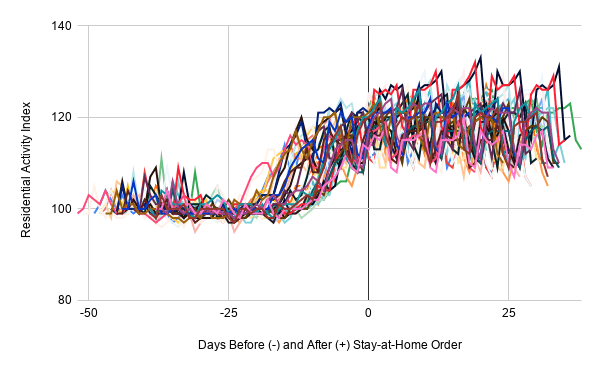Stay-at-Home Orders and the Willingness to Stay Home

There is much debate about the desirability of state-issued stay-at-home orders. On one side, those in favor of lifting the orders argue that the cure is worse than the disease. Some maintain that the disease is not as bad as most experts claim. Others merely note the devastating psychological and economic effects of isolation and reluctantly accept that many lives will be lost from opening up.
On the other side, those in favor of the stay-at-home orders argue that a few months of isolation is a small price to pay to save lives. Some reject the idea of considering the trade-off when lives are on the line altogether. Others deny the trade-off on the grounds that mass casualties would have an even bigger negative effect on our psychological and economic well-being.
If there is one thing that both sides seem to agree on, however, it is that state-level stay-at-home orders induced people to stay at home. In fact, the available evidence indicates that much of the change in activity occurring in March resulted prior to the effective dates of state-level stay-at-home orders.
In a new paper released last Friday, I analyze Google Mobility data and find that 76.60 percent of the change in residential (+), 75.61 percent in retail and recreation (−), 75.81 percent in workplace (−), 74.42 percent in transit station (−), and 19.58 percent in grocery and pharmacy (−) activity preceded state-level stay-at-home orders. I also estimate that 67.54 to 86.13 percent of the decline in park activity resulted before state-level stay-at-home orders were imposed, though the estimates for the decline in park activity before and after stay-at-home orders warrant less confidence.

The magnitude of change resulting prior to state-level stay-at-home orders implies that much of the consequences would have likely been realized—for better or worse—even if states had not imposed stay-at-home orders. In other words, the marginal effect of state-level stay-at-home orders, at least at the outset, was probably smaller than most people claim.
The evidence cuts both ways. On the one hand, it means state-level stay-at-home orders probably had a modest effect on slowing the spread of COVID-19. On the other hand, it means state-level stay-at-home orders probably deserve little blame for reducing economic activity.
Why were state-level stay-at-home orders less effective than most people think? There is much more empirical work to be done to be sure. But, in large part, I think they were less effective because they came well after many other steps had been taken. Many individuals had already reduced unnecessary trips out. Many businesses had already moved to remote work. Many local governments had already adopted stay-at-home or limited capacity orders or required some businesses to close.
Democratically-elected governments are usually slow to respond. And higher-level governments generally respond more slowly than lower-level governments. That’s a feature, not a bug.
Governments can do great things. They can also do terrible things. Constraining a government, by requiring its leaders to stand for election, tends to reduce the speed at which it might do great things. Elected leaders will generally wait until they are confident their policies enjoy widespread support before enacting them. But it also helps protect the citizenry from some of the terrible things a government might do. Elected leaders will generally wait until they are confident their policies enjoy widespread support before enacting them.
The compromise made at federal and state levels is made more tolerable by local governments and a strong civil society. Local governments are also constrained by democratic elections. But they need only wait until the majority of those in their jurisdiction approves of a policy. As a result, they tend to be more responsive to local conditions.
Civil society refers to our non-governmental, non-commercial interactions. It is our families, religious institutions, and our social clubs. It is the disapproving glance we give to a neighbor who doesn’t mow his lawn. It is the smile and nod we give to the girl who helps younger students cross the street safely after school. Civil society does not work perfectly, to be sure. But it is capable of accomplishing quite a bit.
It has become common, in times of crisis, to ask: what will the government do to fix this? And there is certainly a lot that state and federal governments can do. The lesson I hope we will learn from this pandemic, however, is that there is much that can be accomplished locally as well.
It begins with the choices we make as individuals and members of a community. Be responsible. Praise those you see acting prudently; shame those who impose unnecessary risks on others. But, in doing so, we must also be very understanding when the line between prudence and recklessness is unclear.










